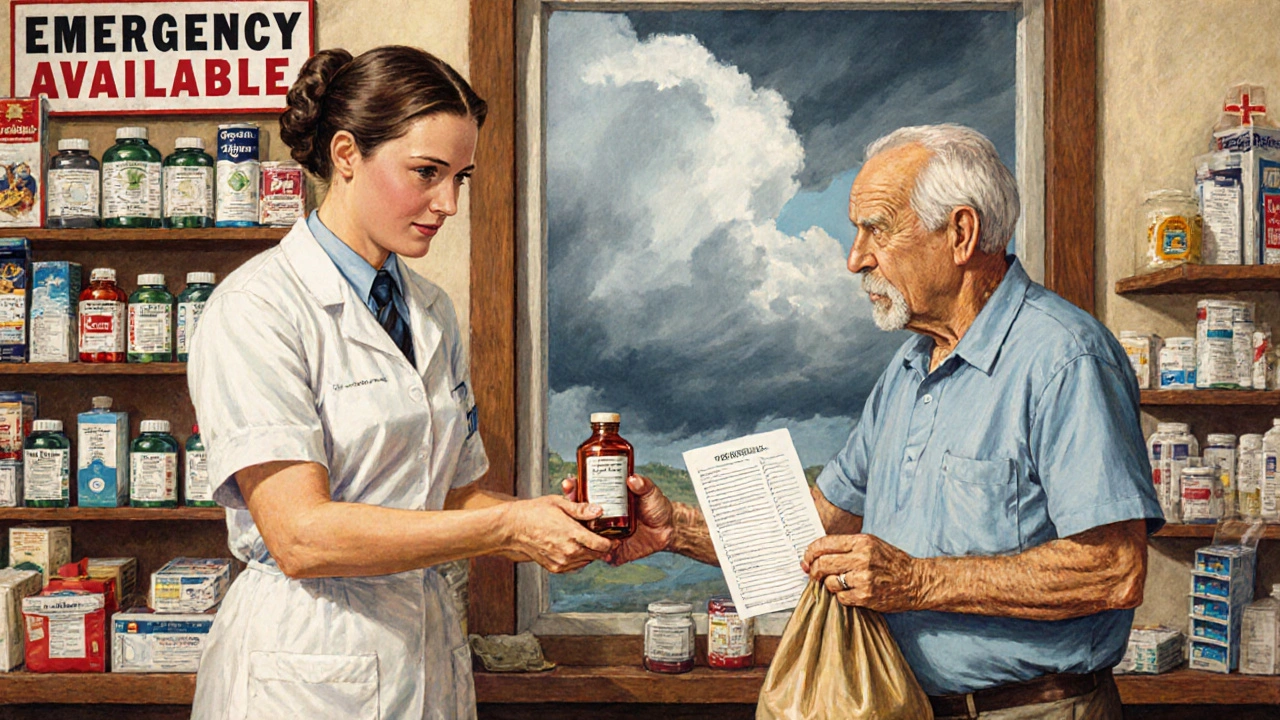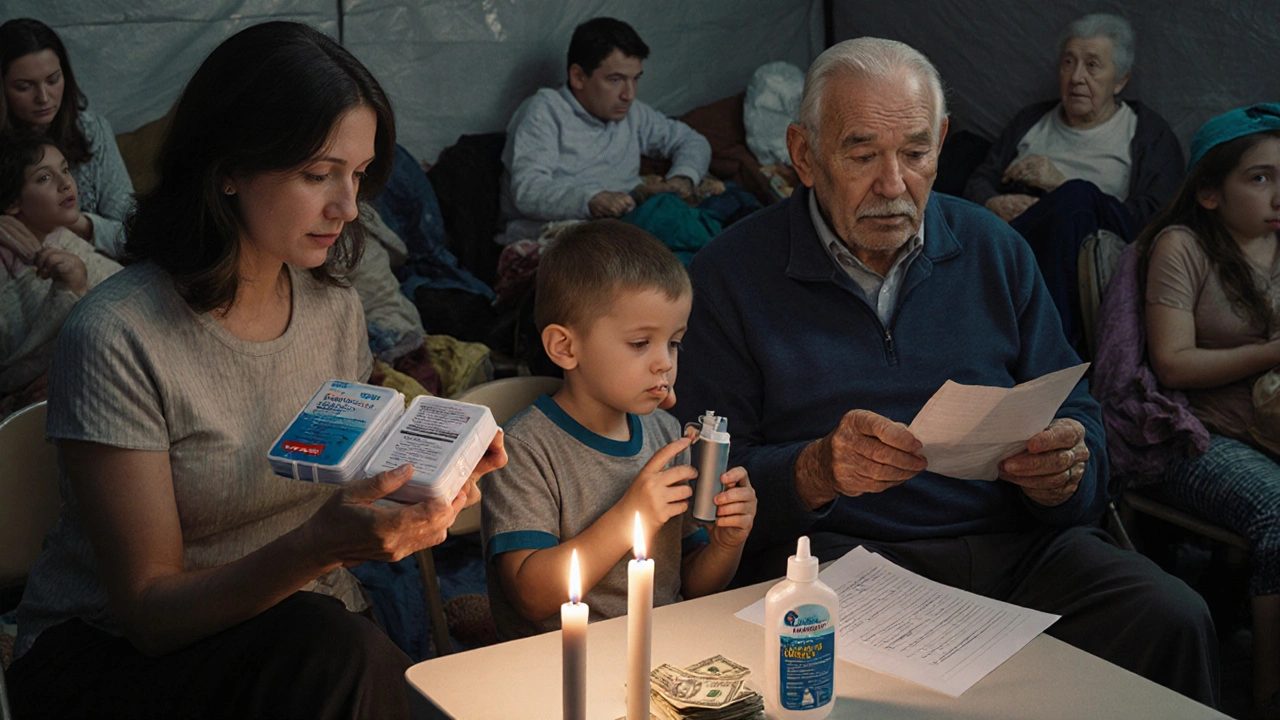Medication Safety in Emergencies: What to Keep in Your Go-Bag

When disaster strikes-whether it’s a flood, wildfire, or sudden power outage-your first thought shouldn’t be, "Where are my pills?" Yet, for millions of people, that’s exactly what happens. In 2022, FEMA reported that 23% of evacuees during Hurricane Ida didn’t have enough medication to last more than a few days. That’s not just inconvenient-it’s dangerous. People with heart conditions, diabetes, or asthma can end up in the ER because they ran out of their daily meds. And it’s not just about running out. If your insulin gets too hot, your epinephrine loses potency, or your blood pressure pills get wet, you’re not just out of luck-you’re at risk.
Why a Medication Go-Bag Isn’t Optional
A go-bag isn’t just a backpack with canned food and bottled water. For people who take daily medication, it’s a lifeline. The CDC says 89% of Americans over 65 take at least one prescription drug. But only 22% of households have a go-bag with enough meds to last through an emergency. That gap is deadly. Emergency rooms see a 38% spike in visits during disaster recovery, and nearly a third of those cases involve people who couldn’t access their heart or diabetes meds. You don’t need to be elderly to be at risk. People with epilepsy, thyroid disorders, mental health conditions, or even chronic pain rely on daily meds. If you take something every day, you need a plan.What to Put in Your Go-Bag: The Essentials
Start simple. You don’t need fancy gear. Just the basics, organized and ready to grab. Here’s what works:- At least a two-week supply of all prescription medications. Some sources say seven days. That’s not enough. Hurricanes, earthquakes, and wildfires can cut off access for weeks. Alert San Diego and the CDC both recommend 14 days. If your doctor gives you 30-day refills, ask for two at a time. Many pharmacies will let you get an early refill if you explain you’re preparing for emergencies.
- Over-the-counter meds you use regularly. That means pain relievers, antacids, allergy pills, or even stool softeners. Don’t assume you’ll find them in a shelter. Supplies run out fast.
- Original prescription bottles. Keep meds in their original containers with labels intact. Emergency staff need to know the exact name, dosage, and prescribing doctor. No more guessing if that blue pill is for blood pressure or anxiety.
- A printed medication list. Write down every drug you take: name, dose, frequency, reason you take it, and your doctor’s name and phone number. Include allergies and any past reactions. Put this in a waterproof sleeve or ziplock bag.
- Emergency contact info. Include a family member or friend who knows your medical history. If you’re unconscious, this could save your life.
- Medical documents. Copies of insurance cards, advance directives, or a living will. Keep them together with your medication list.
Special Cases: Insulin, Epinephrine, and Temperature-Sensitive Drugs
Not all meds are created equal. If you use insulin, epinephrine auto-injectors, or biologics, you’ve got extra challenges. These drugs can spoil if they get too hot or too cold. Standard go-bags don’t protect them.- Insulin starts breaking down after 28 days at room temperature-but in a hot car or a shelter with no AC, it can degrade in hours. The CDC says 62% of diabetics struggle with this during power outages. Solution: Use a Frio Wallet or similar cooling pack. These reusable gel packs keep insulin below 86°F for up to 48 hours without electricity. Test yours before you need it.
- Epinephrine (like EpiPens) loses potency after expiration. Expired pens can fail when you need them most. Don’t wait until the day of the emergency to check the date. Replace them on schedule. If you’re low on refills, talk to your pharmacist-they can often give you an emergency supply in a declared disaster.
- Other temperature-sensitive drugs include certain antibiotics, thyroid meds, and injectables. Check the label. If it says “store in refrigerator,” you need a way to keep it cool. A small insulated cooler with ice packs works. But don’t let the meds freeze. Some drugs can be ruined by freezing.

Storage and Maintenance: Don’t Let Your Go-Bag Go Bad
A go-bag you never check is worse than none at all. Expired meds can be useless-or harmful. Here’s how to keep yours ready:- Store it in a cool, dry place. Not the bathroom. Not the garage. A high shelf in your bedroom closet works. Humidity and heat kill pills.
- Check it every six months. Set a reminder on your phone for January 1 and July 1. Look at expiration dates. Toss anything expired. Replace it right away.
- Rotate your supply. Use the oldest meds first. When you refill a prescription, add the new bottle to the back of your go-bag. Move the old one to the front. That way, you’re always using the freshest supply.
- Use pill organizers with dates. If you take multiple pills a day, a weekly organizer with labels helps you know what’s been taken. But don’t rely on it alone-keep originals too.
- Keep it accessible. Your go-bag should be ready to grab in under 30 seconds. Don’t lock it away. Don’t tuck it under boxes. Put it by the door.
What You Might Forget (But Shouldn’t)
People focus on pills. But there’s more:- Medical devices. If you use a nebulizer, CPAP machine, oxygen tank, or glucose monitor, keep extra batteries and a manual. Include cleaning supplies if needed.
- Hydration. Some meds require extra water. Diuretics, lithium, and some antibiotics can cause dehydration. Include at least one extra liter of water per person per day.
- Small bills. Cash. $50-$100 in small denominations. ATMs and credit card systems go down in disasters.
- Hand sanitizer and wipes. You won’t always have clean hands before taking meds. Keep a small bottle in the bag.
Real Stories, Real Lessons
One woman in Florida lost her home to Hurricane Ian. She had a go-bag with seven days of meds. She was stuck for 11 days. She ran out of insulin. Her blood sugar spiked. She ended up in the ER. She now keeps two weeks’ worth. Another man in California had his home burned in a wildfire. His EpiPen was in a plastic bag in his car. The heat warped it. He couldn’t use it when he had a reaction. He survived, but barely. He now uses a Frio Wallet and checks his expiration dates monthly. These aren’t rare cases. They’re common. And they’re preventable.
Getting Help: Talk to Your Pharmacist
Your pharmacist isn’t just someone who hands out pills. They’re your emergency ally. In 42 states, pharmacists can give you an emergency supply of meds without a new prescription during a declared disaster. Ask them:- Can I get a 90-day supply instead of 30?
- Can you give me an extra bottle for my go-bag?
- Do you have a list of emergency contacts if I can’t reach my doctor?
It’s Not Just for You
If you care for a child, elderly parent, or someone with special needs, make a go-bag for them too. Kids with asthma need their inhalers. Seniors with dementia need their meds labeled clearly. Don’t assume someone else will handle it. Be the one who prepares.What’s Next?
By 2025, FEMA aims to raise the percentage of households with proper medication go-bags from 22% to 35%. That’s progress. But it’s not enough. Climate change means more disasters. More people will need more meds. The technology is here-cooling packs, temperature sensors, digital records. The only thing missing is action. Start today. Don’t wait for the storm. Don’t wait for the power to go out. Open your medicine cabinet. Look at your prescriptions. Ask yourself: If I had to leave now, would I have what I need? If the answer isn’t a clear yes, it’s time to build your bag.How long should my medication go-bag last?
Aim for at least a two-week supply. While some guidelines suggest seven days, disasters like wildfires or hurricanes can cut off access for longer. The CDC and Alert San Diego both recommend 14 days, especially if you have chronic conditions like diabetes or heart disease. More is better-especially if you live in a high-risk area.
Can I keep my insulin in my go-bag without refrigeration?
Yes, but only with proper cooling. Insulin can spoil in heat. Use a Frio Wallet or similar cooling pack, which keeps it below 86°F for up to 48 hours without electricity. Test it before you need it. Never leave insulin in a hot car or direct sunlight. If you’re unsure, ask your pharmacist for advice.
Should I keep my meds in original bottles?
Yes. Emergency responders need to know the exact drug name, dosage, and prescribing doctor. Pill organizers are helpful for daily use, but original bottles with labels are required for safety and legal reasons. If you must transfer meds, keep the original container in the bag alongside the organizer.
What if I forget to refill my meds before an emergency?
In many states, pharmacists can give you an emergency supply without a new prescription during a declared disaster. Call your pharmacy first. If they can’t help, go to the nearest ER-they’re required to provide meds for life-threatening conditions. But don’t rely on this. Always plan ahead. Fill prescriptions early and keep extra in your go-bag.
Do I need to include over-the-counter meds?
Yes. You might need pain relievers, antacids, allergy pills, or even laxatives. Shelters don’t always have them, and you can’t assume you’ll find what you need. Include anything you take regularly-even if it’s not prescription.
How often should I check my go-bag?
Every six months. Set a reminder for January 1 and July 1. Check expiration dates, replace anything old, and update your medication list if your prescriptions changed. This takes 15 minutes but can save your life.